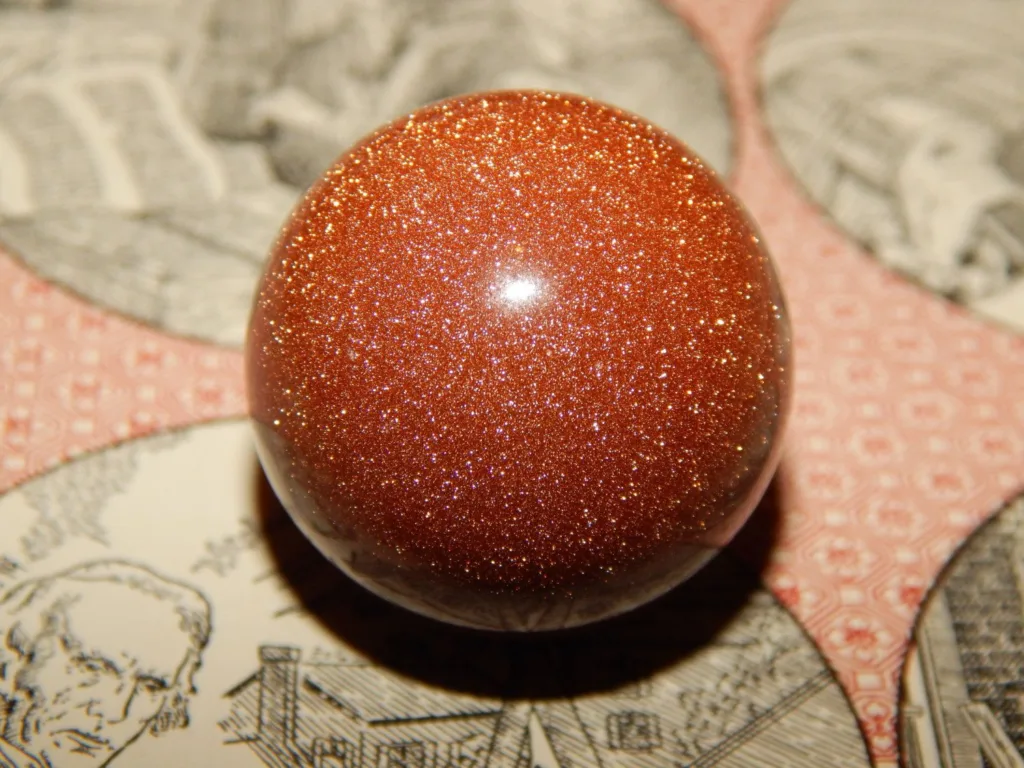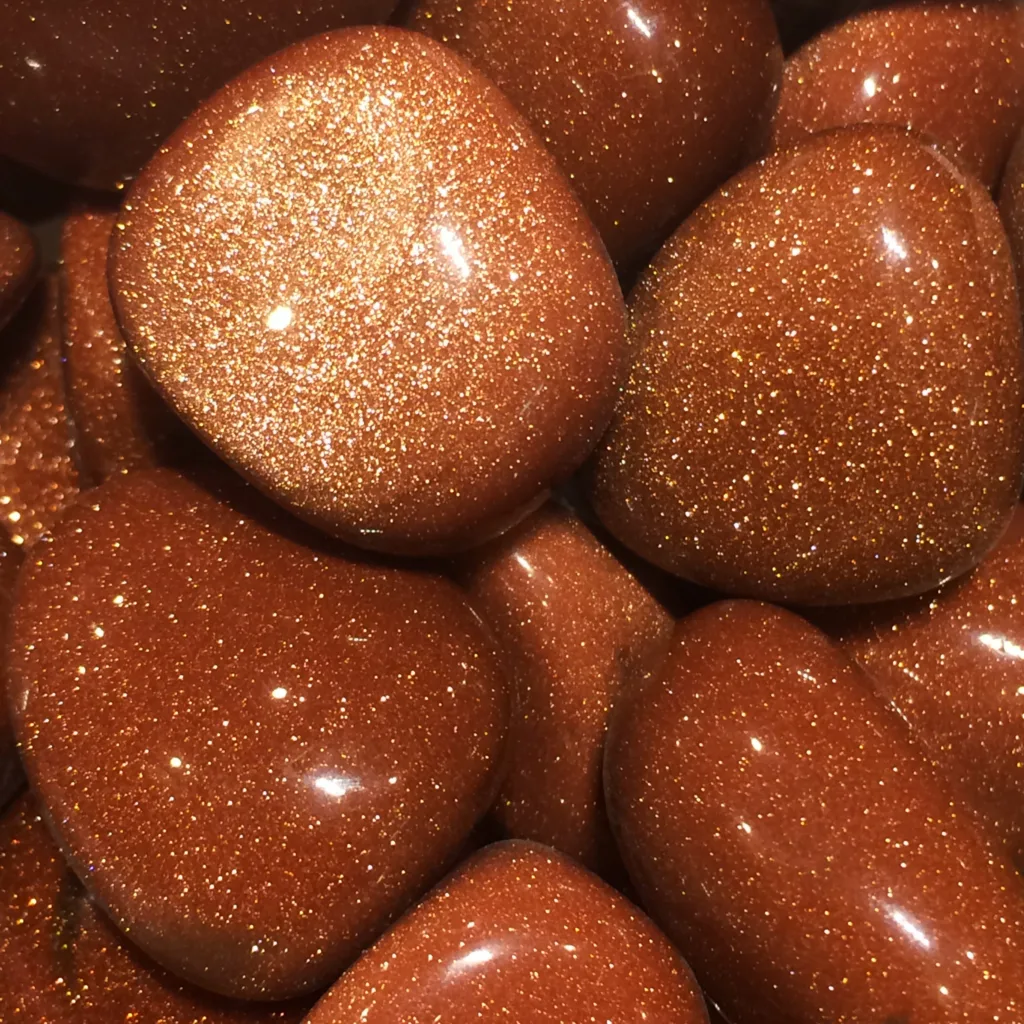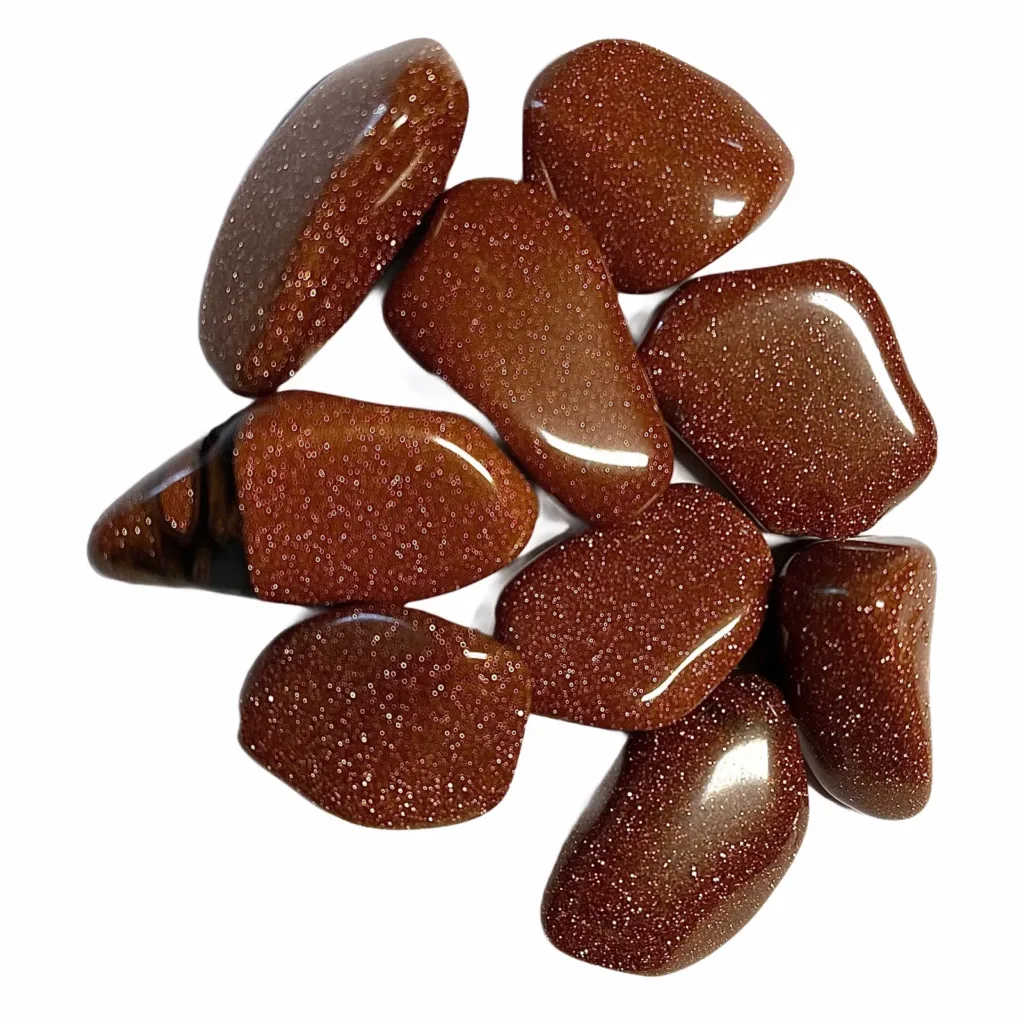Goldstone is a man-made glass material known for its shimmering appearance, created by embedding tiny metallic particles, usually copper or other metals, within the glass during the manufacturing process. It is often used in jewelry, decorative items, and artistic glasswork due to its unique and attractive sparkly luster.

Goldstone is a type of glass that contains tiny metal or metallic oxide particles, usually copper, chromium, or other elements, suspended within it. These particles give goldstone its distinct and dazzling appearance, with numerous glittering specks that can resemble stars or glitter. It is typically dark in color, with variations including blue, green, red, and brown, but the most common color is a deep reddish-brown.
Goldstone is created by heating a mixture of silica (sand), copper salts, and other compounds in a controlled environment. As the mixture cools down, it forms a glass with the characteristic metallic sparkles. Various manufacturing techniques can produce different shades and types of goldstone, such as blue goldstone and green goldstone.
Historical Significance: The history of goldstone dates back to ancient times when it was first crafted in Italy, primarily in the city of Venice, during the Renaissance period. Venetian glassmakers were renowned for their skill in producing glass with exceptional clarity and colors, and goldstone was one of their creations. It was initially known as “aventurine glass” because it was believed to bring good luck or fortune to those who possessed it.
Throughout history, goldstone has been used for various ornamental and decorative purposes. It was often incorporated into jewelry, sculptures, and intricate glassware. Due to its shimmering appearance, it was highly prized and considered a symbol of wealth and luxury.
Goldstone’s popularity has endured over the centuries, and it continues to be used in contemporary jewelry and decorative items. While it lacks the geological rarity and natural origins of other gemstones, its unique beauty and historical significance have contributed to its enduring appeal.
In summary, goldstone is a man-made glass with a distinct metallic appearance, created by embedding tiny metallic particles within the glass during the manufacturing process. It has a rich history, especially in Venice, Italy, where it was crafted and celebrated for its aesthetic qualities and symbolic meaning. Today, goldstone remains a popular choice for jewelry and decorative items, appreciated for its timeless sparkle and historical significance.
Formation of Goldstone

Goldstone is a man-made glass with a unique glittering appearance, and it is created through a specific manufacturing process. The formation of goldstone involves carefully controlled heating and cooling of a mixture of materials to create the characteristic sparkles. Here’s a step-by-step explanation of how goldstone is formed:
- Raw Materials: The primary raw materials used in the production of goldstone include silica (often derived from sand), copper salts (typically copper oxide), and other compounds that can contribute to the desired color and appearance of the final product. These materials are finely ground into a powder.
- Mixing: The powdered raw materials are thoroughly mixed to ensure a homogeneous blend. The exact composition of the mixture may vary depending on the desired color and type of goldstone being produced.
- Melting: The mixed powder is then placed in a high-temperature furnace or kiln. The temperature in the furnace is carefully controlled to reach a point where the raw materials begin to melt and fuse together. This process typically occurs at temperatures above 1,000 degrees Celsius (1,800 degrees Fahrenheit).
- Cooling: Once the mixture has reached the molten state, it is slowly cooled down in a controlled manner. The cooling rate is essential for the formation of goldstone’s characteristic sparkles. As the molten glass cools, the metallic particles within it start to separate and crystallize, creating the glittering effect.
- Formation of Inclusions: The key to goldstone’s appearance is the presence of tiny metallic particles or inclusions within the glass. These inclusions can be copper, chromium, or other metallic elements, and they are responsible for the reflective, glittery flecks that give goldstone its metallic luster. The inclusions are suspended within the glass matrix during the cooling process.
- Shaping and Cutting: After the glass has cooled and solidified, it can be shaped into various forms, such as beads, cabochons, or other jewelry components. It can also be cut and polished to reveal its sparkles and luster.
- Final Processing: Depending on the intended use, goldstone may undergo additional treatments or processes to enhance its appearance or durability. This can include additional polishing, coating, or setting into jewelry pieces.
It’s important to note that goldstone is entirely synthetic and does not occur naturally. Its name, which suggests a natural mineral or gemstone, can be misleading. Despite its artificial origin, goldstone’s dazzling appearance and unique charm have made it a popular choice for jewelry and decorative items throughout history.
Types of Goldstone

Goldstone comes in various types and colors, each with its unique appearance and characteristics. The different types of goldstone are primarily distinguished by the colors and materials used during the manufacturing process. Here are some of the most common types of goldstone:
- Red Goldstone: Red goldstone is the most well-known and widely recognized type of goldstone. It has a deep reddish-brown color with abundant sparkling copper inclusions. The copper inclusions give it a warm and fiery appearance, and it’s often used in jewelry, especially for beads and cabochons.
- Blue Goldstone: Blue goldstone has a rich blue color and is often considered one of the most attractive variations of goldstone. It contains cobalt or other elements that create its blue hue. The sparkling inclusions in blue goldstone can resemble a starry night sky, making it a popular choice for jewelry, beads, and decorative items.
- Green Goldstone: Green goldstone, also known as green aventurine glass, features a green or teal color. Chromium compounds are typically used to achieve this green hue. Like other goldstone types, it has sparkling inclusions, and its green color can vary in intensity. Green goldstone is used in jewelry and ornaments.
- Brown Goldstone: Brown goldstone is similar in appearance to red goldstone but with a more brownish tone. It contains copper inclusions like red goldstone, but the coloration gives it a more earthy and subdued look. Brown goldstone is often used for jewelry and decorative items.
- Purple Goldstone: Purple goldstone is a less common variety, and it is characterized by its purple or violet hue. To achieve this color, goldstone makers may use manganese or other additives. The purple shade, combined with the sparkles, makes it an attractive choice for jewelry and artistic glasswork.
- Gold Goldstone: Gold goldstone is a variant that has a vibrant golden-yellow or orange-yellow color. It typically contains a higher concentration of copper, which imparts a bright, metallic appearance. Gold goldstone is less common than other types but can be used for jewelry and decorative pieces.
- Black Goldstone: Black goldstone is a dark, almost black, variation of goldstone. It contains metallic inclusions that give it a shimmering effect against the dark background. This type of goldstone is used in jewelry and as a decorative material.
- Silver or Gray Goldstone: Silver or gray goldstone is a less common variety, featuring a silver or grayish color. It still possesses the characteristic sparkles, and it can be used for jewelry and decorative items.
- Rainbow Goldstone: Rainbow goldstone is a multi-colored type that contains a mix of different metallic inclusions, creating a colorful and iridescent effect. It can display shades of red, blue, green, and other colors in the same piece. Rainbow goldstone is often used for artistic and unique jewelry designs.
It’s essential to note that the colors and appearance of goldstone can vary depending on the specific manufacturing process and the materials used. Despite being a synthetic glass, goldstone’s shimmering qualities and rich colors have made it a popular choice for jewelry, beads, and various decorative items.
Properties of Goldstone

Goldstone, while not a natural mineral or gemstone, possesses several distinctive properties that make it popular for use in jewelry and decorative items. These properties are primarily related to its appearance, composition, and the manufacturing process. Here are the key properties of goldstone:
- Appearance:
- Sparkling Luster: Goldstone is known for its striking, metallic-like luster, characterized by countless glittering specks. These sparkles resemble stars or glitter and create a captivating visual effect.
- Various Colors: Goldstone comes in a range of colors, including red, blue, green, brown, purple, gold, black, silver, and more, depending on the additives used during production. Each color has its unique charm.
- Composition:
- Man-Made Glass: Goldstone is entirely synthetic and is not a naturally occurring mineral or gemstone. It is a type of glass created through controlled heating and cooling of specific materials, including silica, copper salts, and other compounds.
- Metallic Inclusions: The defining feature of goldstone is the presence of tiny metallic particles or inclusions, typically copper, chromium, or other metals. These inclusions are suspended within the glass matrix and are responsible for the sparkling effect.
- Hardness:
- Moderate Hardness: Goldstone, being a type of glass, has a moderate hardness on the Mohs scale, typically around 5.5 to 6.5. While it is relatively durable, it is not as hard as natural gemstones like diamonds, sapphires, or rubies.
- Transparency:
- Opaque: Goldstone is generally opaque, meaning that it does not allow light to pass through. This opacity is due to the glass matrix and the metallic inclusions within it.
- Density:
- Moderate Density: Goldstone has a moderate density, similar to that of glass, which contributes to its weight and feel when used in jewelry.
- Durability:
- Relatively Durable: Goldstone is resistant to scratches and abrasions, making it suitable for everyday wear in jewelry items like rings, pendants, and earrings. However, like all glass, it is not completely impervious to damage and should be handled with care.
- Variability:
- Variations in Appearance: The appearance of goldstone can vary within each type and color due to differences in manufacturing processes, materials, and conditions. This variability can lead to unique and one-of-a-kind pieces.
- Historical Significance:
- Symbolism: Goldstone has a historical significance as a symbol of luck and wealth, especially in the form of “aventurine glass.” It was believed to bring good fortune and was highly prized in the past.
- Artistic Use:
- Decorative Appeal: Goldstone is frequently used in artistic glasswork, sculptures, and decorative items due to its captivating appearance. It is also utilized in mosaics and other artistic applications.
- Jewelry:
- Common Use: Goldstone is often used in jewelry design, including necklaces, bracelets, earrings, and rings. Its sparkly appearance makes it a popular choice for both casual and formal jewelry pieces.
While goldstone may lack the geological rarity and natural origin of other gemstones, its unique properties and glittering allure have contributed to its popularity and continued use in various forms of art, jewelry, and decoration.
Uses and Applications

Goldstone, with its unique appearance and properties, has a range of uses and applications in various fields. Here are some common uses and applications of goldstone:
- Jewelry: Goldstone is a popular choice for jewelry designers due to its sparkling appearance and availability in various colors. It is used to create a wide range of jewelry items, including necklaces, bracelets, earrings, rings, and pendants. Goldstone jewelry can add a touch of elegance and glamour to both casual and formal outfits.
- Beads and Cabochons: Goldstone beads and cabochons are commonly used in jewelry making. Beads are strung together to create necklaces and bracelets, while cabochons are polished, rounded, and used as focal points in jewelry designs.
- Ornaments and Decorative Items: Goldstone’s shimmering qualities make it a popular choice for decorative items, such as figurines, vases, paperweights, and other ornamental pieces. Its sparkling effect can enhance the aesthetic appeal of these items.
- Artistic Glasswork: Goldstone is often employed by glass artists and craftsmen to create intricate glasswork, including sculptures, vases, and stained glass windows. Its unique appearance adds an element of luxury and elegance to these artistic creations.
- Mosaics: Goldstone can be used in mosaic art, where it is cut into small pieces and incorporated into intricate mosaic patterns and designs. Its sparkle can create eye-catching mosaic artworks for interior and exterior decoration.
- Lapidary Projects: Craftsmen and lapidaries may use goldstone to create custom gemstone shapes, cabochons, and carvings for jewelry or artistic purposes. Its wide range of colors allows for creative lapidary work.
- Healing and Metaphysical Uses: Some individuals believe that goldstone has metaphysical and healing properties. It is said to promote self-confidence, vitality, and positivity. It is sometimes used in crystal healing practices, meditation, and energy work.
- Lucky Charms and Amulets: Historically, goldstone was considered a symbol of luck and wealth. It was often used as a talisman or amulet to attract good fortune and prosperity. Some people still carry or wear goldstone for these purposes.
- Gifts and Souvenirs: Goldstone items, especially jewelry and decorative pieces, are often chosen as gifts for various occasions, including birthdays, anniversaries, and holidays. They can serve as memorable and aesthetically pleasing presents.
- Collectibles: Some collectors appreciate goldstone items for their historical significance and unique colors. Collectors may seek out vintage goldstone jewelry, glasswork, and other collectible pieces.
- Fashion Accessories: Goldstone can be incorporated into fashion accessories like hairpins, brooches, and belt buckles, adding a touch of elegance and sparkle to clothing and accessories.
It’s important to note that while goldstone is highly valued for its appearance and versatility, it is a synthetic material, and its properties and symbolism differ from those of natural gemstones. Despite not being a naturally occurring mineral, goldstone has found its niche in the world of art, fashion, and decoration due to its captivating and eye-catching qualities.




































